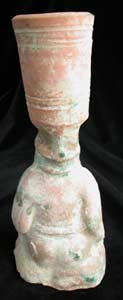Eastern Han Terracotta Lamp in the Form of a Mother and Child, 23 CE - 220 CE
Terracotta
4.5 x 10.75
PF.3592
Further images
The Han Dynasty, like the Zhou before it, is divided into two distinct periods, the Western Han (206 B.C.-9 A.D.) and the Eastern Han (23-220 A.D.) with a brief interlude....
The Han Dynasty, like the Zhou before it, is divided into two distinct periods, the Western Han (206 B.C.-9 A.D.) and the Eastern Han (23-220 A.D.) with a brief interlude. Towards the end of the Western period, a series of weak emperors ruled the throne, controlled from behind the scenes by Wang Mang and Huo Guang, both relatives of empresses. They both exerted enormous influence over the government and when the last emperor suddenly passed away, Mang became ruling advisor, seizing this opportunity to declare his own Dynasty, the Xin, or “New.” However, another popular uprising began joined by the members of the Liu clan, the family that ruled the Han Dynasty, the Xin came to a quick end and the Eastern Han was established in its place with its capital at Loyang (Chang’an, the capital of the Western Han, was completely destroyed).
However, even as Chinese influence spread across Southeastern Asia into new lands, the Eastern Han Dynasty was unable to recreate the glories of the Western Period. In fact, this period can be characterized by a bitter power struggle amongst a group of five consortial clans. These families sought to control the young, weak emperors with their court influence. Yet, as the emperors became distrustful of the rising power of the clans, they relied upon their eunuchs to defend them, often eliminating entire families at a time. During the Western Han, the Emperor was viewed as the center of the universe. However, this philosophy slowly disintegrated under the weak, vulnerable rulers of the Eastern Han, leading many scholars and officials to abandon the court. Eventually, the power of the Han would completely erode, ending with its dissolution and the beginning of the period known as the “Three Kingdoms.”
The Han pottery shows a considerable advance in ceramic technique. Many of Han vessels, such as the wine vases or the oil lamps, are elegant in form. They are ornamented with artistic designs in a variety of ways, by painting with unfired pigments, by stamping, by the application of reliefs that have been separately formed in moulds, and by incising. For the first time, Han dynasty potters used glaze, a transparent lead glaze of yellowish tone which is colored green with copper oxide and variegated by the use of liquid clays or slips of different color. The underlying body of the glazed ware is usually red and this showing through the transparent glaze gives a brown or reddish brown surface, when the glaze has not been colored green by the use of copper. This magnificent pottery lamp depicts a kneeling figure holding a small child, whose arms are outstretched. The figure wears a long robe that cascades over the curves of the body, and the facial features are rendered distinctly in proportion. The oil vessel is placed on the top of the head, as if the figure is wearing a large headdress. The vessel's form is vertical and long, and the top and bottom are decorated with incised lines. The pottery lamp is also beautifully enhanced with light reddish-brown color, over which traces of green glaze accentuate graceful curves of the sculpture. As we contemplate this lamp, we can envision an enchanting place in ancient china that was lit by this lamp.
However, even as Chinese influence spread across Southeastern Asia into new lands, the Eastern Han Dynasty was unable to recreate the glories of the Western Period. In fact, this period can be characterized by a bitter power struggle amongst a group of five consortial clans. These families sought to control the young, weak emperors with their court influence. Yet, as the emperors became distrustful of the rising power of the clans, they relied upon their eunuchs to defend them, often eliminating entire families at a time. During the Western Han, the Emperor was viewed as the center of the universe. However, this philosophy slowly disintegrated under the weak, vulnerable rulers of the Eastern Han, leading many scholars and officials to abandon the court. Eventually, the power of the Han would completely erode, ending with its dissolution and the beginning of the period known as the “Three Kingdoms.”
The Han pottery shows a considerable advance in ceramic technique. Many of Han vessels, such as the wine vases or the oil lamps, are elegant in form. They are ornamented with artistic designs in a variety of ways, by painting with unfired pigments, by stamping, by the application of reliefs that have been separately formed in moulds, and by incising. For the first time, Han dynasty potters used glaze, a transparent lead glaze of yellowish tone which is colored green with copper oxide and variegated by the use of liquid clays or slips of different color. The underlying body of the glazed ware is usually red and this showing through the transparent glaze gives a brown or reddish brown surface, when the glaze has not been colored green by the use of copper. This magnificent pottery lamp depicts a kneeling figure holding a small child, whose arms are outstretched. The figure wears a long robe that cascades over the curves of the body, and the facial features are rendered distinctly in proportion. The oil vessel is placed on the top of the head, as if the figure is wearing a large headdress. The vessel's form is vertical and long, and the top and bottom are decorated with incised lines. The pottery lamp is also beautifully enhanced with light reddish-brown color, over which traces of green glaze accentuate graceful curves of the sculpture. As we contemplate this lamp, we can envision an enchanting place in ancient china that was lit by this lamp.





